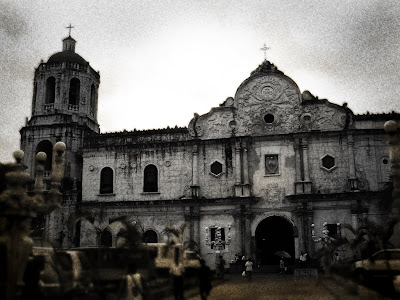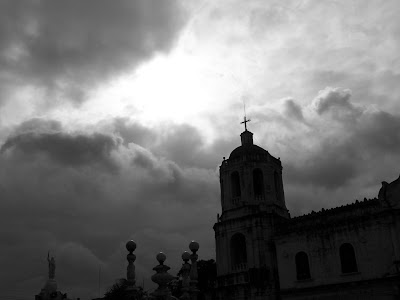Cebu Cathedral
 The Cebu Cathedral took about a century to complete because of frequent interruptions. One of three diocese created in 1595 (the other two being Nueva Segovia and Nueva Caceres), Cebu was raised to the status of archdiocese in 1934 with the dioceses of Calbayog, Jaro, Zamboanga, Bacolod, and Cagayan de Oro as suffragans. During the Spanish period, Cebu had the most extensive territory because Guam and the Marianas fell under its jurisdiction. Only in 1898, because of the Treaty of Paris, did Cebu lose these territories.
The Cebu Cathedral took about a century to complete because of frequent interruptions. One of three diocese created in 1595 (the other two being Nueva Segovia and Nueva Caceres), Cebu was raised to the status of archdiocese in 1934 with the dioceses of Calbayog, Jaro, Zamboanga, Bacolod, and Cagayan de Oro as suffragans. During the Spanish period, Cebu had the most extensive territory because Guam and the Marianas fell under its jurisdiction. Only in 1898, because of the Treaty of Paris, did Cebu lose these territories.Despite it age and status, Cebu did not have a cathedral worthy of it for many decades. The first church was built in 1595 of wood, bamboo and thatch. Although stone walls were added it was in a sorry state according to a 1667 report of Bp. Juan Lopez to the King of Spain. To remedy this, Bp. Diego de Aguilar began a new church but was unable to finish; his successor Bp. Miguel Bayot instead of completing what had been started began a new structure. Again he was not able to accomplish much. Bp. Sebastian de Foronda found the building too small and inappropriate, calling it a "barn." Again work was discontinued.
In 1719, the military engineer Juan de Ciscara was commissioned to design the cathedral. He opted for a cruciform design with short transepts. He placed the altar mayor at the crossing, reserved the apse for the altar de pardon, and placed the choir stalls for the cathedral canon in the nave. Work on the construction was suspended when funds were diverted to military campaigns against slave raiders. Construction began in 1734, was interrupted four years later, resumed in 1741 under Bp. Protasio Cabezas. The facade was completed in 1786 and in 1811 the cathedral was blessed. The completed cathedral departed from Ciscara’s plans. It was renovated in 1829, 1836 when Bp. Santos Marañon, who designed other churches in Cebu, designed and built the bell tower. The cathedral was improved in 1886, during the incumbency of Bp. Gorordo, and in 1939. Damaged during World War II, architect Jose Zaragosa rebuilt the cathedral in 1959. The cathedral's interior was renovated recently.
Heritage Features: Because of damage caused by World War II and the recent renovation, nothing of the historical interior remains, however, the exterior remains 18th century. The 21 meter high facade is capped by a pediment shaped like a trefoil. The monogram IHS decorates the upper register pediment while small circular openings decorate the lower part. A pair of griffins and bas-relief floral designs fill the pediment. The two story facade is divided vertically by paired columns on a tall plinth and the cornice over the main door is broken and emblazoned with a coat of arms in low relief.
The Episcopal Palace of Cebu stands outside the enclosed plaza in front of the cathedral. One of two Spanish colonial episcopal palaces still remaining, the residence is an oversized bahay na bato, Its construction is typical of 19th century domestic architecture: a lower story of stone and an upper story of wood. The palace is being restored to house an ecclesiastical museum. The old altar from the cathedral will be displayed in the museum.
-----------------
Text taken from Panublion
Images by: Me.



Comments